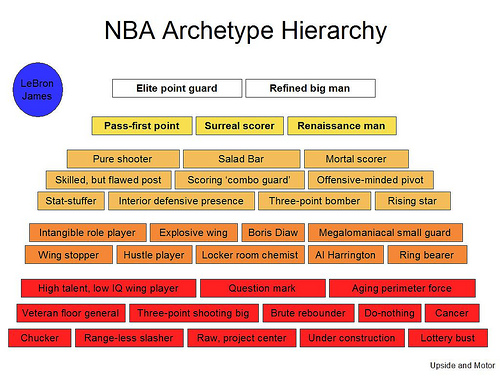
Full disclosure: Part of the reason I love Upside and Motor's newly-unveiled NBA Archetypes so much is that FD has been discussing a similar model. Or maybe we did this, kind of, with the categories in the book. But he did it thorough, and I can't stop thinking about it. So here's the main image, and let's talk about it.
Actually, I really just want to use it to present my once-and-for-all argument for the age limit, something I developed during a shouting match at our Vassar appearance. While I don't exactly agree with Rob's hierarchy—big men of any kind seem to really get short shrift, even by my standards—it does clearly illustrate the rise of the guard that we've often discussed 'round these parts. The dream is of landing a Chris Paul, Deron Williams or Derrick Rose, who as recently history has borne out, are actually easier to build around, and thus truer franchise players, than the likes of the titanic Yao or Dwight Howard. Yes, refined big man is up there with point guard supreme, because the absolute gems of that category are still invaluable. But they've become 1B to the point guard's 1A. And, almost absurdly, you have to look down to the fourth tier to find another archetype that specifically requires size.
Again, I think that's a little batty. Still, it shows how far we've come from the "size conquers all" outlook, at least according to one model of things. While you usually hear about "need" versus "best available" (draft concepts that actually should more often be extended to include free agency and trades), the pro-height bias was almost a philosophy unto itself. In fact, it almost encapsulated, or subsumed, both of the others: Big players were always the best available, and you could always use height, because size wins.

And that, dear readers, is why I support the age limit. Let's not pretend that coming out of high school was about equal rights and opportunity for all. Teams disproportionately favored tall players; in fact, it was a truism that no one drafted high school guards. I can count on one hand the non-big men who ended up with favorable draft position: Kobe, T-Mac, Sean Livingston (length), Telfair (sneaker conspiracy), Webster (huh?), J.R. Smith (blueprint shooting guard, non-lottery), Gerald Green (dropped like crazy). Let's not forget about the 2005 draft, when Monta Ellis, Louis Williams, and C.J. Miles all fell into the second round, when at least one of them was projected to go in the first. Who went first overall last summer? Derrick Rose, who certainly deserved it. Would he have gone that high out of high school? Absolutely not. That just wasn't the culture of high school scouting.
There's a perfect confluence here of the rise of the point guard, which came about as a combination of Nash's MVP's and the success of Paul and Williams, and teams being forced to wait another year before delivering their final verdict on a player. High school big men were drafted on size, athleticism, and some semblance of coordination. Scoring wings or guards didn't just have to have outlandish numbers—who doesn't in high school—but also the size and physical ability that made them sound pro prospects. The likes of Williams, Ellis, and Miles might as well have been playing with counterfeit dollars. And then when you get to point guards, it's just impossible to judge how well they play with others until they're 1) forced to by stronger competition 2) given the opportunity to do so in a complex way, by having a coach 3) have teammates who can really take advantage of their brilliance. Don't believe me? Take a look at Chris Paul's assist numbers in high school (thanks to Kyle for that one) and college.
So if we all agree that guards, especially the pointy type, are gaining in value, but require more scouting, and big men are drafted on crude factors and no longer rule the game, the age limit makes perfect sense. Put simply, it gives the greatest opportunity to the greatest number of players, not just those born with tremendous height. The argument at Vassar hinged on the Williams/Ellis/Miles troika. The other side claimed that their being drafted showed that the age limit worked for guards. My point was, it shows that it didn't. Had Monta spent a year in college, he would've been a no-brainer lottery pick.
Anyway, we can debate Rob's archetypes further, but certainly it's a product of today's game and scouting climate, and makes a case that, in some ways, there have been shifts in this post-Suns era. Though that doesn't mean that Tim Duncan still wouldn't be picked over Rose, or even Paul, with hindsight.

BONUS: By popular demand, the saga continues:
HOLY COW ALERT: How did I not know until just now that D'Antoni had been on the Spirit of St. Louis?















No comments:
Post a Comment